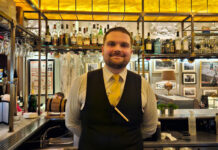
PROMOTING long drinks and cocktails is key to boosting sales of liqueurs in bars.
That’s the message from producers and distributors, who told SLTN operators who highlight a range of different serves for the liqueurs on their gantry stand to benefit as the category continues to grow beyond its traditional after-dinner occasion.
Sarah Harding, senior brand manager at First Drinks, distributor of Tia Maria and Disaronno, said consumers are now factoring liqueurs into their regular drinks repertoires.
“It depends on who’s buying and trying,” she told SLTN.
“A number of liqueurs are still drunk by the consumers that have always drunk them – and their consumption tends to be in a very traditional way, so drunk neat or in coffee; but more and more the category has grown and they’re used more and more in cocktails and long mixed drinks.
“I think people are much more fluid in how they choose their drinks, and now buy more from a repertoire than from a single drink or category.”
In a bid to highlight the versatility of liqueurs, First Drinks has been working with bartenders to promote a range of serves for Tia Maria and Disaronno, ranging from straightforward Tia Maria and cranberry juice and Disaronno and cola to more complex cocktails.
It’s an approach that Harding reckons has helped make liqueurs accessible to a broader range of consumers.
“I think the key to unlocking liqueurs is the mixability and versatility of them,” she added.
“It doesn’t have to be a complex cocktail, it can be a simple serve.”
First Drinks isn’t the only company focusing on new serves and cocktails.
Liqueurs is one of the drinks categories covered by Maxxium’s Mixxit bartender training programme, with the distributor promoting basic ‘highball’ serves for its Sourz brand.
“Our focus this summer will continue to be on quick and tasty serves,” said Maxxium UK’s on-trade sales director Jim Grierson.
“There’s nothing simpler and tastier than the highball, which is simply a spirit, mixer and a fresh citrus wedge. The team are travelling the country on a mission to help every pub serve the perfect highball every time.

“The advantage that this category has over others is that the age demographic is much wider: it appeals to younger as well as mature drinkers. This is due to the versatility of serving styles and diversity of flavours, which meet a wide variety of occasions.”
VC2 Brands, the company behind liqueur brands Stivy’s and Paris Rose, argues that younger, “modern” brands have played a key role in attracting younger consumers to the category.
“The modern brands have for the first time presented liqueurs to a younger audience with new zingy flavours and creative, more up to date packaging,” said VC2 co-founder Carlo Valente.
He advised operators to review their liqueurs range at least once a year, and said they shouldn’t be afraid to introduce some new or unusual brands.
“They [operators] should never get stuck with liqueurs,” he added.
“No matter how slow they are [selling], with a little work and imagination they can move slow-moving lines to make room for others.
“Innovative serves or introducing a new cocktail are great ways to promote liqueurs. Making sure that liqueurs don’t get hidden on the gantry behind other brands, giving them a share of voice and giving the customer more choice [is also important].”
The growing popularity of liqueurs has prompted distributor Global Brands to renew its focus on the Goldschläger brand this year.
The company, which distributes the liqueur on behalf of brand owner Diageo, will be promoting a number of different serves throughout the year, including cocktails and long drinks.
“Where liqueurs were once considered an after-dinner treat, the future for this category looks bright as brands adapt their offering to appeal to more contemporary drinkers,” said Global Brands’ Simon Green.
“Today’s consumers, and particularly the 25 to 30 year old crowd, are more aspirational than ever when it comes to what they drink and where. Today’s successful liqueur brands are those that differentiate themselves from the competition to offer consumers a special drinking experience through being unique, memorable or premium.”



















